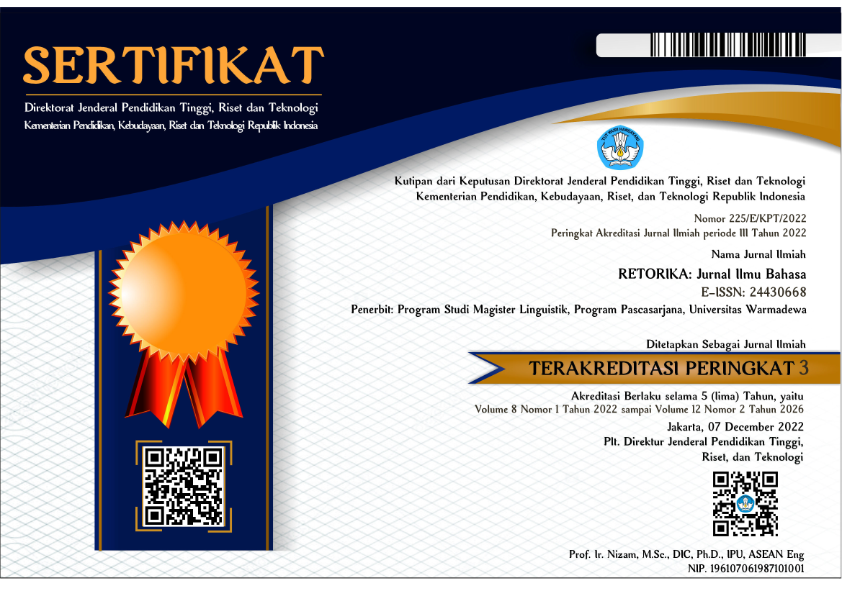An Analysis of Slang Words Used in Social Media (Instagram)
Abstract
The research titled "An Analysis of Slang Words Used in Social Media (Instagram)" investigates the use of slang in Instagram captions and comments. The study aims to describe the types and functions of slang words used by Instagram users and to understand the sociolinguistic factors influencing their usage. Through qualitative descriptive analysis, data were collected from various Instagram accounts, focusing on the frequency and context of slang word usage. The findings indicate that slang is prevalent on Instagram, serving to create a sense of community and belonging among users, while also reflecting cultural and social dynamics. This study provides valuable insights into the evolving nature of language in digital communication and highlights the importance of understanding slang as a linguistic phenomenon in social media interactions.
References
Alshehri, S. (2023). The Relationship between Language and Identity. International Journal of Linguistics, Literature and Translation, 6(7), 156–161. Retrieved from https://doi.org/10.32996/ijllt.2023.6.7.14
Altun, M. (2023). The Power of Language: Exploring its Significance in Shaping Perceptions, Beliefs, and Relationships. International Journal of Social Sciences & Educational Studies, 10(3). Retrieved from https://doi.org/10.23918/ijsses.v10i3p362
Chang, C.-W., & Chang, S.-H. (2023). The Impact of Digital Disruption: Influences of Digital Media and Social Networks on Forming Digital Natives’ Attitude. SAGE Open, 13(3). Retrieved from https://doi.org/10.1177/21582440231191741
Kandiawan, A. B. (2022). Code-Switching and Slang Used by Gen Z Indonesians on Social Media. ELTR Journal, 7(1), 48–56. Retrieved from https://doi.org/10.37147/eltr.v7i1.165
Killeen, P. R. (2018). The Futures of Experimental Analysis of Behavior. Behavior Analysis: Research and Practice, 18(2), 124–133. Retrieved from https://doi.org/10.1037/bar0000100
Lighter, J. E. (2001). Slang. In The Cambridge History of the English Language (pp. 219–252). Cambridge University Press. Retrieved from https://doi.org/10.1017/CHOL9780521264792.007
Nasution, F., & Tambunan, E. E. (2022). Language and Communication. International Journal of Community Service (IJCS), 1(1), 01–10. Retrieved from https://doi.org/10.55299/ijcs.v1i1.86
Nasution, J. S., Rahmadeny, M., & Jazzawi, I. (2019). The Importance of Sociolinguistics in Foreign Language Education: A Review of Selected Paper. International Journal for Educational and Vocational Studies, 1(4). Retrieved from https://doi.org/10.29103/ijevs.v1i4.1415
Scott-Phillips, T. C. (2007). The Social Evolution of Language, and the Language of Social Evolution. Evolutionary Psychology, 5(4), 147470490700500. Retrieved from https://doi.org/10.1177/147470490700500405
Zhou, Y., & Fan, Y. (2013). A Sociolinguistic Study of American Slang. Theory and Practice in Language Studies, 3(12). Retrieved from https://doi.org/10.4304/tpls.3.12.2209-2213
Copyright (c) 2024 RETORIKA: Jurnal Ilmu Bahasa

This work is licensed under a Creative Commons Attribution-ShareAlike 4.0 International License.
This journal provides immediate open access to its content on the principle that making research freely available to the public supports a greater global exchange of knowledge.
All articles published Open Access will be immediately and permanently free for everyone to read and download. We are continuously working with our author communities to select the best choice of license options, currently being defined for this journal as follows: Creative Commons-Non Ceomercial-Attribution-ShareAlike (CC BY-NC-SA)
 Abstract viewed = 292 times
Abstract viewed = 292 times
 PDF downloaded = 356 times
PDF downloaded = 356 times

2.png)














